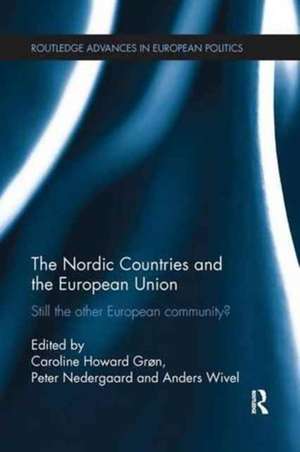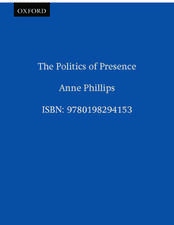The Nordic Countries and the European Union: Still the other European community?: Routledge Advances in European Politics
Editat de Caroline Grøn, Peter Nedergaard, Anders Wivelen Limba Engleză Paperback – 11 noi 2016
This book offers a coherent, original and systematic comparative analysis of the relationship between the Nordic countries and the European Union over the past two decades. It looks at the historical frame, institutions and policy areas, addressing both traditional EU areas such as agriculture and more nascent areas affecting the domestic and foreign policies of the Nordic countries. In doing so, it examines how the Nordic approach to European policy-making has developed and explains why the Nordic countries are similar in some respects while differing in others when engaging with EU institutions. In highlighting the similarities and differences between the Nordic countries it explores what lessons – positive and negative – may be drawn from this approach for the Nordic countries and other small states.
This book will be of interest to scholars, students and practitioners engaged with the Nordic Countries, EU politics and policy-making, European politics and comparative politics.
| Toate formatele și edițiile | Preț | Express |
|---|---|---|
| Paperback (1) | 449.41 lei 43-57 zile | |
| Taylor & Francis – 11 noi 2016 | 449.41 lei 43-57 zile | |
| Hardback (1) | 1113.12 lei 43-57 zile | |
| Taylor & Francis – 23 feb 2015 | 1113.12 lei 43-57 zile |
Din seria Routledge Advances in European Politics
-
 Preț: 324.96 lei
Preț: 324.96 lei -
 Preț: 311.41 lei
Preț: 311.41 lei -
 Preț: 324.87 lei
Preț: 324.87 lei -
 Preț: 356.63 lei
Preț: 356.63 lei -
 Preț: 137.51 lei
Preț: 137.51 lei -
 Preț: 285.03 lei
Preț: 285.03 lei - 9%
 Preț: 1037.85 lei
Preț: 1037.85 lei - 18%
 Preț: 1115.33 lei
Preț: 1115.33 lei - 18%
 Preț: 1002.95 lei
Preț: 1002.95 lei - 18%
 Preț: 1058.79 lei
Preț: 1058.79 lei - 18%
 Preț: 1055.69 lei
Preț: 1055.69 lei -
 Preț: 326.03 lei
Preț: 326.03 lei - 18%
 Preț: 1007.36 lei
Preț: 1007.36 lei - 18%
 Preț: 1060.87 lei
Preț: 1060.87 lei - 18%
 Preț: 1010.60 lei
Preț: 1010.60 lei - 18%
 Preț: 1057.13 lei
Preț: 1057.13 lei - 18%
 Preț: 1057.61 lei
Preț: 1057.61 lei - 18%
 Preț: 1059.93 lei
Preț: 1059.93 lei - 18%
 Preț: 1061.93 lei
Preț: 1061.93 lei - 18%
 Preț: 998.40 lei
Preț: 998.40 lei - 18%
 Preț: 1114.64 lei
Preț: 1114.64 lei - 18%
 Preț: 1058.43 lei
Preț: 1058.43 lei - 18%
 Preț: 1112.03 lei
Preț: 1112.03 lei - 18%
 Preț: 1057.75 lei
Preț: 1057.75 lei - 18%
 Preț: 1055.21 lei
Preț: 1055.21 lei -
 Preț: 370.71 lei
Preț: 370.71 lei - 18%
 Preț: 1050.02 lei
Preț: 1050.02 lei - 18%
 Preț: 1001.21 lei
Preț: 1001.21 lei - 18%
 Preț: 973.89 lei
Preț: 973.89 lei - 25%
 Preț: 828.12 lei
Preț: 828.12 lei -
 Preț: 393.26 lei
Preț: 393.26 lei - 18%
 Preț: 1062.62 lei
Preț: 1062.62 lei - 18%
 Preț: 706.91 lei
Preț: 706.91 lei - 18%
 Preț: 1273.35 lei
Preț: 1273.35 lei -
 Preț: 394.19 lei
Preț: 394.19 lei - 18%
 Preț: 1061.57 lei
Preț: 1061.57 lei - 18%
 Preț: 1060.25 lei
Preț: 1060.25 lei - 18%
 Preț: 1058.79 lei
Preț: 1058.79 lei - 18%
 Preț: 952.31 lei
Preț: 952.31 lei - 18%
 Preț: 1057.75 lei
Preț: 1057.75 lei - 18%
 Preț: 1054.71 lei
Preț: 1054.71 lei - 18%
 Preț: 1059.84 lei
Preț: 1059.84 lei - 25%
 Preț: 823.63 lei
Preț: 823.63 lei - 26%
 Preț: 765.01 lei
Preț: 765.01 lei - 18%
 Preț: 947.36 lei
Preț: 947.36 lei - 18%
 Preț: 1113.95 lei
Preț: 1113.95 lei - 16%
 Preț: 248.97 lei
Preț: 248.97 lei -
 Preț: 352.36 lei
Preț: 352.36 lei - 26%
 Preț: 822.36 lei
Preț: 822.36 lei
Preț: 449.41 lei
Nou
Puncte Express: 674
Preț estimativ în valută:
85.100€ • 90.01$ • 71.57£
85.100€ • 90.01$ • 71.57£
Carte tipărită la comandă
Livrare economică 31 martie-14 aprilie
Preluare comenzi: 021 569.72.76
Specificații
ISBN-13: 9781138238381
ISBN-10: 1138238384
Pagini: 294
Ilustrații: 36
Dimensiuni: 156 x 234 x 22 mm
Greutate: 0.45 kg
Ediția:1
Editura: Taylor & Francis
Colecția Routledge
Seria Routledge Advances in European Politics
Locul publicării:Oxford, United Kingdom
ISBN-10: 1138238384
Pagini: 294
Ilustrații: 36
Dimensiuni: 156 x 234 x 22 mm
Greutate: 0.45 kg
Ediția:1
Editura: Taylor & Francis
Colecția Routledge
Seria Routledge Advances in European Politics
Locul publicării:Oxford, United Kingdom
Public țintă
Postgraduate and UndergraduateCuprins
Contents List of illustrations List of contributors Preface Anders Wivel, Caroline Howard Grøn and Peter Nedergaard 1. Still the ‘Other’ European Community? The Nordic Countries and the European Union Anders Wivel, Caroline Howard Grøn and Peter Nedergaard 2. Bridging Interdependency? Nordic ‘Yes, But…’ Integration from a Historical Perspective Lee Miles 3. The Outsiders: Norway and Iceland Baldur Thorhallson 4. Nordic Cooperation in the EU Council: Does the Institutional Embeddedness Matter? Ilze Rûse 5. The Nordic Countries and the European Commission Caroline Howard Grøn 6. The Nordic Countries and the European Parliament Mads Dagnis Jensen 7. The Nordic Parliaments and the EU Ian Cooper 8. The Common Agricultural Policy: Comparing Danish and Swedish Governmental Positions Peter Nedergaard and Mads Dagnis Jensen 9. Market integration in Europe and the Nordic Countries: The ambivalent path dependency Peter Nedergaard and Mads Dagnis Jensen 10. The European Union and the Nordic models of welfare: path dependency or policy harmonisation? Mikko Kuisma and Mikael Nygård 11. EMU: Joining or not – does it matter? Sixten Korkman 12. Through the EU’s front- and backdoors: The selective Danish and Norwegian approaches in the Area of Freedom, Security and Justice Rebecca Adler-Nissen 13. In the Shadow of History? Explaining the (Lack of) Europeanisation of Nordic Security and Defence Policies Anders Wivel and Martin Marcussen 14. The Nordic Labour Market(s) and the European Union Carsten Strøby Jensen 15. Mr. Svensson Goes to Brussels: Concluding on the Nordic Countries and the European Union Anders Wivel, Caroline Howard Grøn and Peter Nedergaard Bibliography
Notă biografică
Caroline Howard Grøn is Assistant Professor at the University of Copenhagen.
Peter Nedergaard is Professor at the University of Copenhagen.
Anders Wivel is Professor at the University of Copenhagen.
Peter Nedergaard is Professor at the University of Copenhagen.
Anders Wivel is Professor at the University of Copenhagen.
Recenzii
Revecca Pedi, University of Macedonia
'Authors in this anthology explore the relationship between the five Nordic countries and the European Union. They seek to identify the factors that have determined the behaviour and the performance of these states in European policy-making and to see to what extent the Nordic countries form a distinct community in their relationship with the EU.
The main argument of the book is that the Nordic countries have followed a ‘yes, but …’ approach towards European integration. Moreover, it suggests that they form a cluster rather than a unique and united community, while ‘path dependency’ is prevalent among the factors that influence their choices.
Of course, this is not the first time that Nordic states are presented under this spectrum: on the one hand, being pragmatic and harnessing opportunities, yet on the other, remaining reluctant, preserving national policies, interests and values. However, this volume is innovative and noteworthy in many aspects.
First, it is up to date. Second, it is comprehensive. The authors provide extensive coverage of the relationship between the Nordic countries and the EU, initially shedding light on its historical evolution and then exploring it within the EU institutions context. Finally, they examine it across different policy areas. The book offers a comparative analysis which is anchored to institutionalism in terms of theory and also based on a continuum from changeable to unchangeable factors that impact on the Nordic countries’ choices. The authors employ a historical approach, theoretical analysis and current empirical reasoning in tandem and thus provide those who are familiar with the Nordic and/or Small State and/or EU integration literature with a thought-provoking overview and others, less acquainted with this background, with a very informative book.
From its very beginning, the European integration project has posed a series of challenges and opportunities to all Small States. Following the Lisbon Treaty and the global economic crisis, challenges have been intensified. Different Small States have responded in different ways. Small State scholars have sought to find differences and similarities among them. Against this background, in recent years, studies on Small States and EU integration are increasing and constitute probably the larger part of Small State studies. This work contributes to this literature in a unique and much-needed way. Small State studies usually lack such a concurrence of comparative perspective, comprehensive analysis and coherence. Therefore, this volume is one of the very few attempts within the Small State studies field that aims at a systematic exploration of Small State behaviour. It constitutes, hence, a good starting point for reflecting upon a necessary reform in Small State studies.' © The Author(s) 2016
'Authors in this anthology explore the relationship between the five Nordic countries and the European Union. They seek to identify the factors that have determined the behaviour and the performance of these states in European policy-making and to see to what extent the Nordic countries form a distinct community in their relationship with the EU.
The main argument of the book is that the Nordic countries have followed a ‘yes, but …’ approach towards European integration. Moreover, it suggests that they form a cluster rather than a unique and united community, while ‘path dependency’ is prevalent among the factors that influence their choices.
Of course, this is not the first time that Nordic states are presented under this spectrum: on the one hand, being pragmatic and harnessing opportunities, yet on the other, remaining reluctant, preserving national policies, interests and values. However, this volume is innovative and noteworthy in many aspects.
First, it is up to date. Second, it is comprehensive. The authors provide extensive coverage of the relationship between the Nordic countries and the EU, initially shedding light on its historical evolution and then exploring it within the EU institutions context. Finally, they examine it across different policy areas. The book offers a comparative analysis which is anchored to institutionalism in terms of theory and also based on a continuum from changeable to unchangeable factors that impact on the Nordic countries’ choices. The authors employ a historical approach, theoretical analysis and current empirical reasoning in tandem and thus provide those who are familiar with the Nordic and/or Small State and/or EU integration literature with a thought-provoking overview and others, less acquainted with this background, with a very informative book.
From its very beginning, the European integration project has posed a series of challenges and opportunities to all Small States. Following the Lisbon Treaty and the global economic crisis, challenges have been intensified. Different Small States have responded in different ways. Small State scholars have sought to find differences and similarities among them. Against this background, in recent years, studies on Small States and EU integration are increasing and constitute probably the larger part of Small State studies. This work contributes to this literature in a unique and much-needed way. Small State studies usually lack such a concurrence of comparative perspective, comprehensive analysis and coherence. Therefore, this volume is one of the very few attempts within the Small State studies field that aims at a systematic exploration of Small State behaviour. It constitutes, hence, a good starting point for reflecting upon a necessary reform in Small State studies.' © The Author(s) 2016
Descriere
This book offers a coherent, original and systematic comparative analysis of the relationship between the Nordic countries and the European Union over the past two decades. It looks at the historical frame, institutions and policy areas, addressing both traditional EU areas such as agriculture as well as more nascent areas, such as health. In doing so, it examines how the Nordic approach to European policy-making has developed and explains why the Nordic countries are similar in some respects while differing in others when engaging with EU institutions. In highlighting the similarities and differences between the Nordic countries it explores what lessons – positive and negative – may be drawn from this approach for the Nordic countries and other small states.









